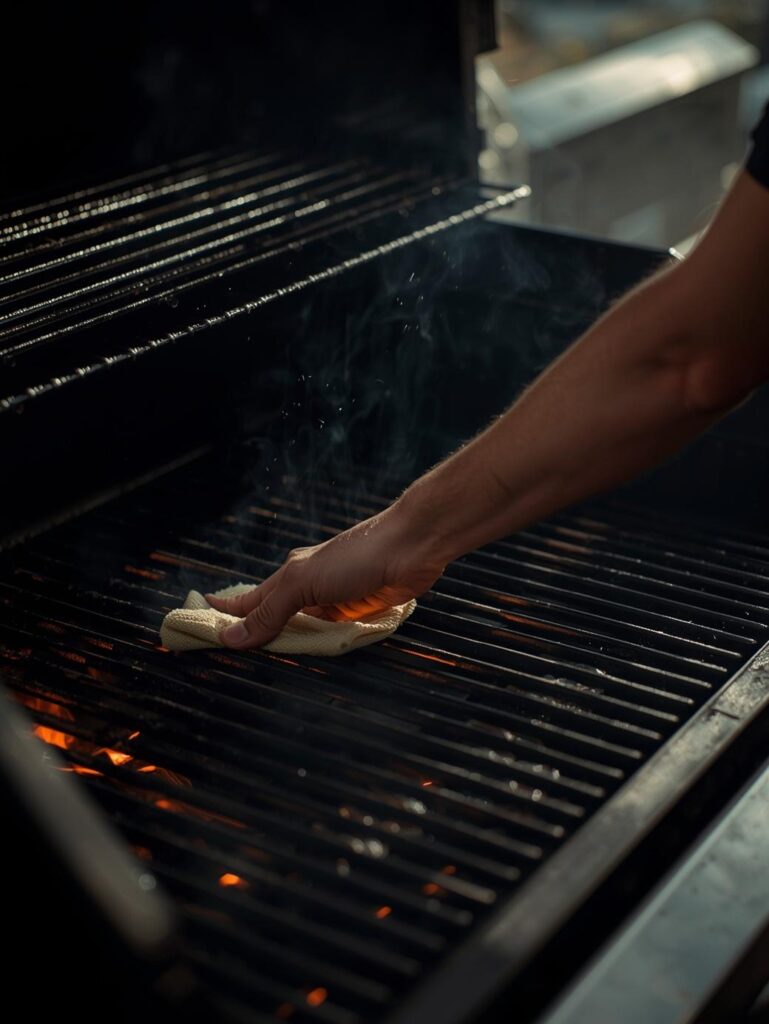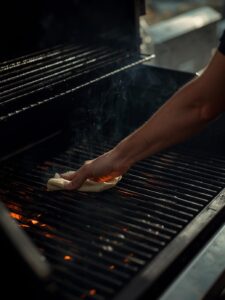Expert’s Note: This guide is part of our comprehensive Ultimate Grill & Smoker Maintenance Guide. Bookmark this page for your seasonal deep cleaning sessions.
Table of Contents Hide Contents🧼 DEEP CLEANING GRILL GUIDE – Deep Cleaning Your Grill – Restore Peak Performance Step-by-Step
“Say goodbye to uneven heating and flare-ups. Our complete deep cleaning system will restore your grill’s like-new performance and add years to its service life.” layss
Build your deep cleaning toolkit with our essential gear checklist and time-saving techniques.Deep Cleaning Your Grill: Restore Peak Performance Step-by-Step
🔥 Why Deep Cleaning Matters More Than You Think
Regular maintenance keeps your grill running, but deep cleaning transforms it. That crusty buildup isn’t just cosmetic – it affects heat distribution, creates hot spots, and can even alter the flavor of your food. More importantly, accumulated grease is a fire hazard waiting to happen.
🎯 The Deep Clean Difference:
- Better Performance: Consistent temperatures and even heating
- Improved Flavor: No old, burnt flavors transferring to new food
- Enhanced Safety: Eliminate grease fire risks
- Longer Lifespan: Prevent corrosion and part failure
🛠️ Pre-Cleaning Assessment & Preparation
📋 Readiness Checklist:
- Grease buildup visible in firebox and drip pans
- Temperature fluctuations or hot spots developing
- Persistent smoke or flare-up issues
- It’s been 3-6 months since last deep clean
- Seasonal change (spring startup or winter prep)
🧰 Essential Deep Clean Toolkit:
- Heavy-duty degreaser or grill cleaner
- Multiple brush types (wire, nylon, brass)
- Scrapers and putty knives for tough buildup
- Microfiber cloths and buckets
- Heat-resistant gloves and safety glasses
- Garbage bags for debris
⚡ The 5-Phase Deep Clean Framework
1. 🔄 Phase 1: Cool Down & Disassembly
Safety First: Ensure grill is completely cool. Never clean a hot grill!
- Take photos before disassembly for easy reassembly
- Remove grates, heat shields, and burners systematically
- Organize parts in order of removal
- Label small parts in bags if needed
2. 🧽 Phase 2: Interior Blitz
Firebox and Interior Walls:
- Scrape heavy buildup with putty knife
- Apply degreaser and let sit 10-15 minutes
- Scrub with appropriate brushes
- Rinse thoroughly and dry completely
3. 🔥 Phase 3: Grate Restoration
Material-Specific Approach:
- Cast Iron: Scrub with brass brush, re-season after cleaning
- Stainless Steel: Use stainless brush, polish with grain
- Porcelain: Gentle nylon brushes only, no abrasives
4. ✨ Phase 4: Exterior Revival
- Clean lid and body with grill-safe cleaner
- Protect control knobs from moisture
- Clean cart and wheels thoroughly
- Apply protective spray to finished surfaces
5. 🔧 Phase 5: Reassembly & Testing
- Reassemble in reverse order of disassembly
- Conduct gas leak test if applicable
- Verify all connections are secure
- Run burn-off cycle to remove cleaning residues
🔧 Grill-Specific Deep Clean Protocols
🔥 Gas Grill Deep Clean
- Inspect burner tubes for spider webs and debris
- Clean venturi tubes with bottle brush
- Check ignition system components
- Test gas connections with soapy water solution
🪵 Charcoal Grill Deep Clean
- Empty and clean ash catcher thoroughly
- Scrape charcoal bowl down to bare metal
- Clean vents and ensure smooth operation
- Inspect charcoal grate for wear
🌲 Pellet Smoker Deep Clean
- Vacuum fire pot and ash throughout system
- Inspect auger for pellet dust buildup
- Clean heat baffles and grease channels
- Test controller and fan operation
Pro Tip: Take before-and-after photos! Not only is it satisfying to see the transformation, but it helps you remember exactly how everything goes back together.
🧪 Advanced Cleaning Techniques
⚗️ Chemical vs Mechanical Cleaning
When to use degreasers: Heavy grease buildup, hard-to-reach areas, time-saving
When elbow grease works better: Delicate surfaces, around electrical components, quick touch-ups
🌿 Natural Cleaning Solutions
- Vinegar spray: Great for exterior surfaces and glass windows
- Baking soda paste: Effective on baked-on carbon without scratching
- Lemon juice: Cuts through grease and leaves fresh scent
🔄 Post-Clean Maintenance Setup
🆕 The Fresh Start Protocol
- Re-season cast iron grates with high-smoke point oil
- Apply protective coating to stainless surfaces
- Lubricate moving parts with high-heat lubricant
- Run initial burn-off to cure any new coatings
📅 Maintenance Schedule Reset
- Set calendar reminder for next deep clean (3-6 months)
- Establish new baseline for grill performance
- Note any parts that need future replacement
- Update your maintenance log
❌ Common Deep Cleaning Mistakes
🚫 What to Avoid:
- Using steel brushes on porcelain surfaces
- Spraying electrical components with liquids
- Rushing reassembly and missing connections
- Skipping the final burn-off cycle
- Using household cleaners not rated for high heat
Essential Maintenance Gear: The right tools make deep cleaning efficient:
🔬 Your Sunday Experiment: Deep Clean Challenge
🎯 This Weekend’s Mission:
1. 🎪 Tackle One Grill Section
- Choose either interior, grates, or exterior
- Apply the complete cleaning protocol
- Document your process and results
2. 💡 Master One New Technique
- Try a new cleaning solution or tool
- Practice proper reassembly sequence
- Learn your grill’s specific maintenance needs
3. 📊 Measure Your Success
- Note temperature consistency improvements
- Observe reduced flare-ups
- Enjoy cleaner food flavor
- Appreciate the professional appearance
Ready for Your Deep Clean Transformation?
Join thousands of grill masters who have rediscovered their grill’s peak performance through proper deep cleaning.
A deeply cleaned grill isn’t just about appearance – it’s about reclaiming peak performance and ensuring every meal is your best work.
Pick one phase from this guide and complete it this weekend. Your taste buds – and your grill – will thank you.
Quick Note: These questions are answered in detail in our full guide above. This FAQ summarizes the key points for quick reference.
❓ FAQ: DEEP CLEANING YOUR GRILL
🕒 1. How often should I deep clean my grill?
Every 3-6 months for regular use, or seasonally. Heavy users should deep clean quarterly, while occasional grillers can do it at the start and end of grilling season. Watch for performance issues like uneven heating as your cue.
🔧 2. What’s the difference between deep cleaning and regular maintenance?
Regular maintenance is the 5-minute post-cook clean (brushing grates, emptying grease). Deep cleaning involves full disassembly, degreasing, and restoring all components to like-new condition.
⚠️ 3. Is it safe to use oven cleaner on my grill?
Generally no. Most oven cleaners contain chemicals that shouldn’t be heated to grill temperatures. Use grill-specific degreasers or natural alternatives like vinegar and baking soda.
⏱️ 4. How long does a full deep clean typically take?
1-3 hours depending on grill size and condition. Gas grills take longest due to more components. Allow extra time for your first deep clean to learn your grill’s assembly.
🔥 5. Do I need to re-season my grates after deep cleaning?
Yes, for cast iron grates. The deep cleaning process strips the seasoning. Re-season immediately after cleaning to prevent rust. Stainless steel and porcelain grates don’t need seasoning.
💧 6. Can I use a pressure washer to clean my grill?
Not recommended. High-pressure water can damage bearings, electronics, and force moisture into areas that are hard to dry, leading to rust. Stick to manual cleaning methods.
🧼 7. What’s the best cleaner for baked-on grease?
Grill-specific degreasers or a baking soda paste. For tough buildup, let the cleaner sit for 10-15 minutes before scrubbing. Avoid steel wool on coated surfaces.
🔍 8. How do I know if my grill needs a deep clean?
Look for these signs: Uneven heating, excessive smoke, persistent flare-ups, visible grease buildup, or off-flavors in your food.
🛑 9. Should I deep clean a brand new grill?
Yes, do an initial burn-off clean. New grills often have manufacturing oils and residues. Heat to high for 15-20 minutes, then brush grates before first use.
🌧️ 10. Can I deep clean my grill in cold weather?
Yes, but with precautions. Work in a well-ventilated area, ensure the grill is completely dry before storing, and avoid cleaning right before freezing temperatures.
💰 11. When should I hire a professional instead of DIY?
Consider professional help for: Gas line issues, electrical problems with pellet grills, structural repairs, or if you’re uncomfortable with disassembly.
🎯 12. What’s the most commonly missed area during deep cleaning?
The grease management system and burner tubes. These hidden areas accumulate debris that affects performance and safety. Always remove and clean drip pans and inspect burner ports.
Still have questions? Drop them in the comments below or explore our Complete Grill Maintenance Guide for more detailed information.



